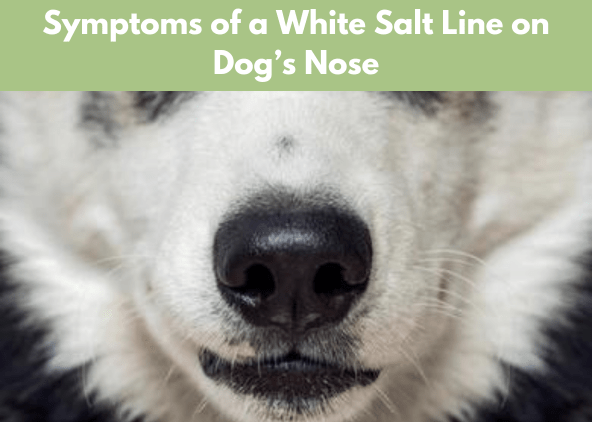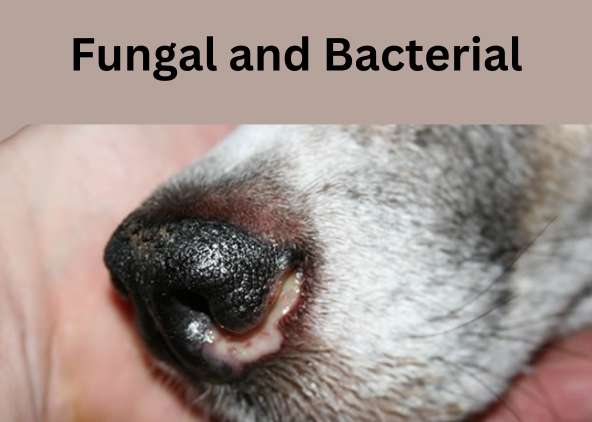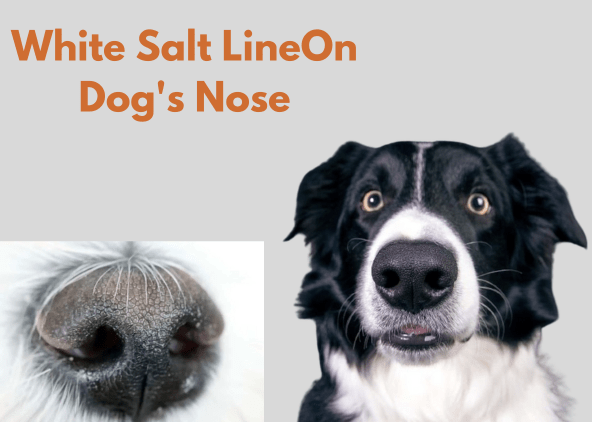Have you ever noticed a white salt line on dog’s nose? This is a common condition that can affect dogs of any breed, age, or gender. It can appear as a thin or thick white line across the nose, or as patches of white on the nose. It can also change in size, shape, or color over time.
But what causes this condition and how can you treat it? In this article, we will explore some of the possible causes of a white salt line on your dog’s nose, how to recognize the accompanying symptoms, and how to prevent and treat this condition at home or with veterinary care.
Causes of a White Salt Line on Your Dog’s Nose
Many factors can cause a white salt line on dog’s nose. Some of the most common ones are:
Vitiligo
- This is a rare skin disease that causes depigmentation of the nose and other parts of the body. It occurs when the immune system attacks the melanocytes, which are the cells that produce pigment. The exact cause of vitiligo is unknown, but it may be related to genetics, infections, stress, or autoimmune disorders. Vitiligo can affect dogs of any breed, but it is more common in some breeds, such as German Shepherds, Rottweilers, Doberman Pinschers, and Siberian Huskies.
Nasal hyperkeratosis
- white line on dog’s nose that causes thickening and scaling of the skin on the nose due to abnormal keratin production. Keratin is a protein that forms the outer layer of the skin, hair, and nails. When keratin accumulates on the nose, it can form a white crust or a salt line. Nasal hyperkeratosis can be caused by several factors, such as aging, genetics, infections, allergies, or environmental irritants. It can affect dogs of any breed, but it is more common in some breeds, such as Labrador Retrievers, Golden Retrievers, Poodles, and Terriers.
Sun exposure
- Dog nose white line is a natural factor that can cause pigmentation changes on the nose due to UV rays. UV rays can damage the melanocytes and cause them to produce less pigment or uneven pigment. This can result in a white salt line or patches of white on the nose. Sun exposure can affect dogs of any breed, but it is more common in dogs with light-colored or pink noses, such as Dalmatians, Boxers, Bulldogs, and Pit Bulls.
Allergies
- This is an immune reaction that can cause inflammation and irritation of the nose due to contact with certain substances. These substances can be food, pollen, dust, mold, chemicals, or medications. When the nose comes in contact with these substances, it can trigger an allergic response that can cause redness, swelling, itching, or a white spot on dog nose. Allergies can affect dogs of any breed, but some breeds may be more prone to them, such as Beagles, Basset Hounds, Cocker Spaniels, and Pugs.
Symptoms and Effects of a White Salt Line on Dog’s Nose
A white salt line on a dog’s nose can be more than just a cosmetic issue. It can also indicate an underlying health problem or affect your dog’s quality of life. Some of the symptoms and effects of a white dot on your dog’s nose are:
Vitiligo
- Besides the white salt line or patches on the nose, vitiligo may also cause loss of hair, itching, pain, or reduced vision. Vitiligo does not affect your dog’s health directly, but it can make it more susceptible to sunburns, infections, or skin cancer. It can also affect your dog’s self-esteem and social interactions, as some dogs may feel embarrassed or rejected by other dogs or humans because of their appearance.
Nasal hyperkeratosis
- Besides the white salt line or crust on the nose, nasal hyperkeratosis may also cause discomfort, difficulty breathing, or reduced sense of smell. Nasal hyperkeratosis can affect your dog’s health by interfering with their ability to breathe, smell, or eat. It can also make your dog more prone to infections, bleeding, or ulcers on the nose. It can also affect your dog’s mood and behavior, as some dogs may feel frustrated or depressed by their condition.
Sun exposure
- Besides the white salt line or patches on the nose, sun exposure may also cause sunburns, wrinkles, or skin cancer. Sun exposure can affect your dog’s health by damaging their skin cells and increasing their risk of developing skin cancer. It can also affect your dog’s comfort and well-being, as some dogs may feel pain, itching, or irritation from sunburns or wrinkles.
Allergies
Besides the white salt line or inflammation on the nose, allergies may also cause sneezing, coughing, itching, or ear infections. Allergies can affect your dog’s health by compromising their immune system and making them more vulnerable to infections or diseases. It can also affect your dog’s happiness and energy, as some dogs may feel miserable or lethargic from allergic reactions.

Prevention and Treatment of a White Salt Line on Your Dog’s Nose
A white salt line on your dog’s nose can be prevented and treated in different ways, depending on the cause and severity of the condition. Some of the tips on how to prevent and treat a white mark on your dog’s nose are:
Vitiligo
- There is no cure for vitiligo, but it can be managed with medications or cosmetic products. Medications such as corticosteroids or immunosuppressants can help reduce the immune system’s attack on the melanocytes and restore some of the pigment. Cosmetic products such as dyes or tattoos can help cover up the white salt line or patches and improve your dog’s appearance. You should consult your veterinarian before using any medications or cosmetic products on your dog’s nose. You should also protect your dog’s nose from sun exposure by applying sunscreen or wearing hats. You should also support your dog’s emotional and social needs by giving them love, attention, and positive reinforcement.
Nasal hyperkeratosis
- The best way to prevent and treat nasal hyperkeratosis is to moisturize your dog’s nose regularly with creams or ointments. Creams or ointments that contain lanolin, petroleum, or shea butter can help soften and hydrate the skin on the nose and prevent the formation of a white salt line or crust. You should apply the cream or ointment at least once a day, preferably after your dog’s meal or bath. You should also avoid irritants or allergens that can trigger or worsen nasal hyperkeratosis, such as plastic bowls, harsh chemicals, or certain foods. You should consult your veterinarian for prescription medications that can help reduce keratin production or treat any infections or ulcers on the nose.
Sun exposure
- The best way to prevent and treat sun exposure is to protect your dog’s nose from UV rays. You should apply sunscreen specially formulated for dogs or humans with sensitive skin on your dog’s nose before going outside. You should also limit your dog’s outdoor time during peak hours, which are between 10 a.m. and 4 p.m. You should also monitor your dog’s nose for signs of sunburn or skin cancer, such as redness, blisters, sores, or lumps. You should consult your veterinarian if you notice any of these signs or if your dog’s nose changes in color, size, or shape.
Allergies
- The best way to prevent and treat allergies is to identify and avoid the triggers. You should observe your dog’s nose and behavior after they come in contact with different substances, such as food, pollen, dust, mold, chemicals, or medications. You should eliminate or reduce the exposure to the substances that cause a white salt line or inflammation on your dog’s nose. You should also use antihistamines or steroids as directed by your veterinarian to help relieve the symptoms of allergies. You should also keep your dog hydrated and comfortable by providing them with fresh water and a cool environment.
Suggested: Step On Dog’s Paw
My Dog Jumped After Being Spayed
My Dog Needs Stitches But I Can’t Afford It
Fungal and Bacterial Infections Caused by a White Salt Line on Dog’s Nose
A white stuff on your dog’s nose can be caused by different factors, such as temperature change, dry skin, or even a fungal or bacterial infection. Here are some possible explanations for each cause:
Fungal or bacterial infection:
A fungal or bacterial infection can also explain a white spot on your dog’s nose. In this instance, you can observe discharge or sores coming from the region. If the discharge dries on the nose, it may leave a white line behind. Moreover, a white scab may develop. Aspergillus fumigatus is the typical culprit behind fungal rhinitis in dogs, and because of this widespread correlation, the terms “aspergillosis” and “fungal rhinitis” are frequently used interchangeably. in dogs is usually caused by a fungus species called Aspergillus fumigatus, and this common association has led to the term ‘aspergillosis’ often being used interchangeably with ’fungal rhinitis’. Bacterial rhinitis in dogs is usually caused by a bacteria species called Staphylococcus aureus, and this common association has led to the term ‘staphylococcus’ often being used interchangeably with ’bacterial rhinitis’.
Snow nose
- Snow nose is a condition that causes the nose to turn white or light pink during the winter months. It does not occur in areas with cold winters, but rather due to reduced sun exposure. Snow nose typically starts with a white or light-colored line in the middle of the nose. It can also spread to other areas of the nose, sometimes turning the entire nose a lighter color. Snow nose is thought to be caused by a lack of tyrosinase, an enzyme that is responsible for pigmentation and melanin in your dog’s body.
Kennel nose
- Kennel nose is a condition that occurs when your dog rubs their nose against the cage, usually out of boredom. Over time, this can rub the skin off the nose, causing it to turn white. Kennel nose is not harmful to your dog’s health, but it may indicate that your dog needs more stimulation and exercise.
Zits
- Zits are pimples that can occur on your dog’s nose, mouth, or genitals. They are caused by clogged pores due to excess oil from food or dirt. Zits will often have a white head, making your dog’s nose look like it has a white spot
- . Zits are not contagious and do not require treatment unless they become infected.
Discoid lupus erythematosus (DLE) is a type of autoimmune disease that affects the skin of dogs, especially the nose. Here is an explanation of how DLE causes a dog’s nose to white line.

What is DLE
- DLE is a condition where the dog’s immune system attacks its skin cells, causing inflammation and damage to the skin.
- DLE mainly affects the nose, but it can also spread to other areas of the face, ears, or genitals.
- DLE is more common in certain breeds, such as German Shepherds, Collies, Shetland Sheepdogs, and Siberian Huskies.
- The exact cause of DLE is unknown, but it may be related to genetics, infections, stress, or environmental factors, such as sun exposure.
How does DLE cause a white line on the dog’s nose?
- DLE causes the skin on the nose to lose its pigment, resulting in a white or light-colored line or patch on the nose.
- DLE also causes the skin on the nose to become dry, scaly, crusty, or ulcerated, which can make the white line more noticeable.
- DLE can also affect the texture of the nose, making it smooth and shiny, instead of rough and bumpy.
- DLE can also cause hair loss, itching, pain, or bleeding on the nose or other affected areas.
How is DLE diagnosed and treated?
- DLE is diagnosed by taking a skin biopsy from the nose or other affected areas and examining it under a microscope.
- DLE is treated by using medications, such as corticosteroids, immunosuppressants, or antibiotics, to reduce the inflammation and infection of the skin.
- DLE is also treated by using topical products, such as moisturizers, sunscreen, or dyes, to protect and improve the appearance of the nose.
- DLE is a chronic condition that requires lifelong management and monitoring by a veterinarian.
Conclusion
A white salt line on dog’s nose is a common condition that can have various causes, such as vitiligo, nasal hyperkeratosis, sun exposure, or allergies. It can also have various symptoms and effects, such as loss of hair, itching, pain, reduced vision, difficulty breathing, reduced sense of smell, sunburns, wrinkles, skin cancer, sneezing, coughing, ear infections, or mood changes.
It can be prevented and treated in different ways, such as moisturizing, avoiding irritants or allergens, protecting from sun exposure, using medications or cosmetic products, or consulting a veterinarian. Keeping your dog’s nose healthy and clean is important for their overall health and well-being.
If you notice a white salt line on your dog’s nose, you should not ignore it or dismiss it as a normal occurrence. You should seek professional advice and care for your dog as soon as possible.
FAQs about white salt line on dog’s nose
Q: What is a white salt line on a dog’s nose?
A. white salt line on a dog’s nose is a condition that causes a thin or thick white line across the nose or patches of white on the nose. It can be caused by various factors, such as vitiligo, nasal hyperkeratosis, sun exposure, allergies, etc.
Q: How can I tell if my dog has a white salt line on their nose?
A. You can tell if your dog has a white salt line on their nose by looking at their nose closely and noticing any changes in color, texture, or shape. You can also check for any accompanying symptoms, such as hair loss, itching, pain, reduced vision, difficulty breathing, reduced sense of smell, sunburns, wrinkles, skin cancer, sneezing, coughing, ear infections, or mood changes.
Q: Is a white salt line on a dog’s nose harmful to their health?
A. white salt line on a dog’s nose can be harmless or harmful, depending on the cause and severity of the condition. Some causes, such as snow nose, kennel nose, or zits, are cosmetic and do not affect your dog’s health directly. However, some causes, such as vitiligo, nasal hyperkeratosis, sun exposure, allergies, or discoid lupus erythematosus, can indicate an underlying health problem or affect your dog’s quality of life. Therefore, it is important to consult your veterinarian if you notice a white salt line on your dog’s nose that persists or worsens over time.




